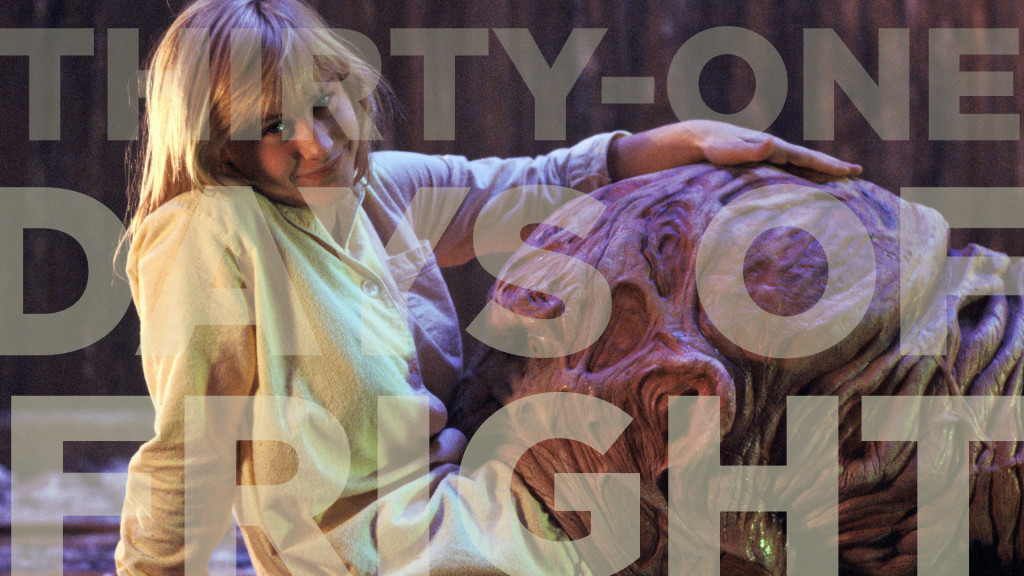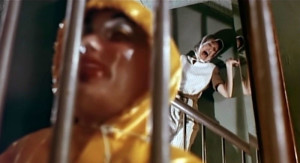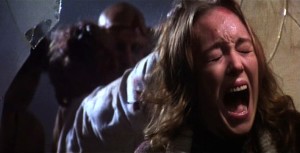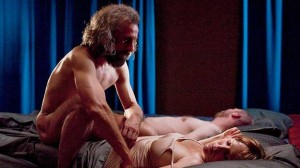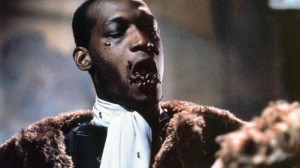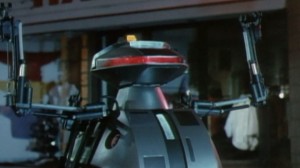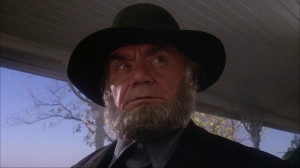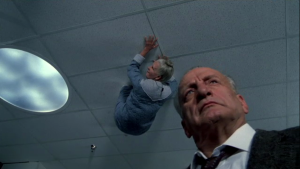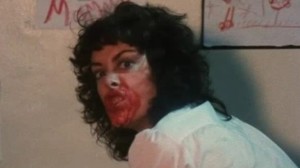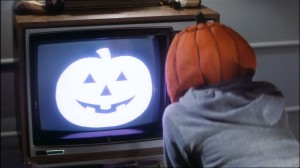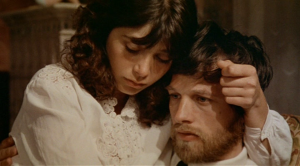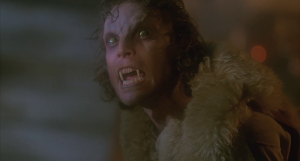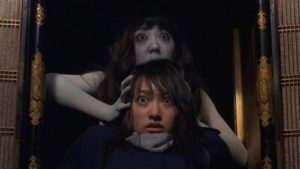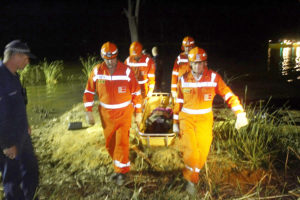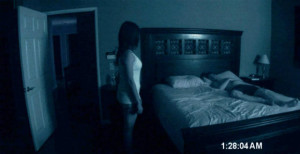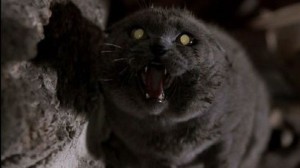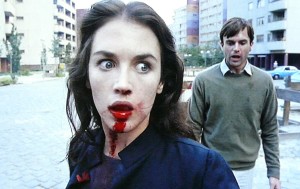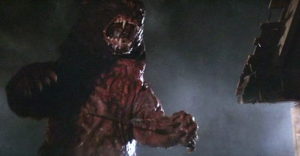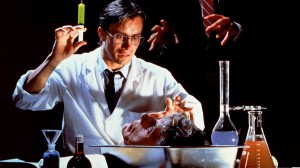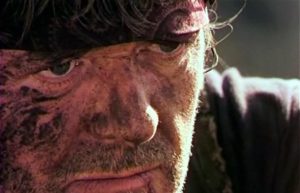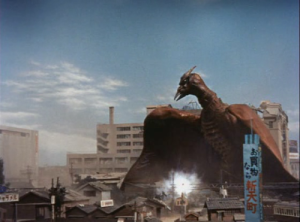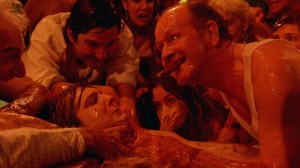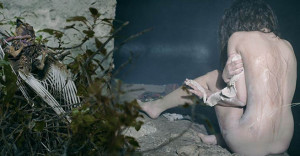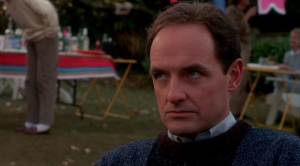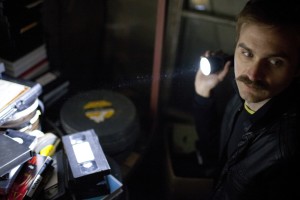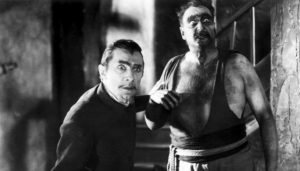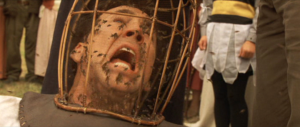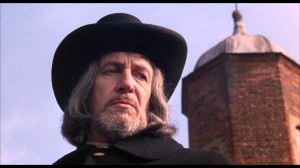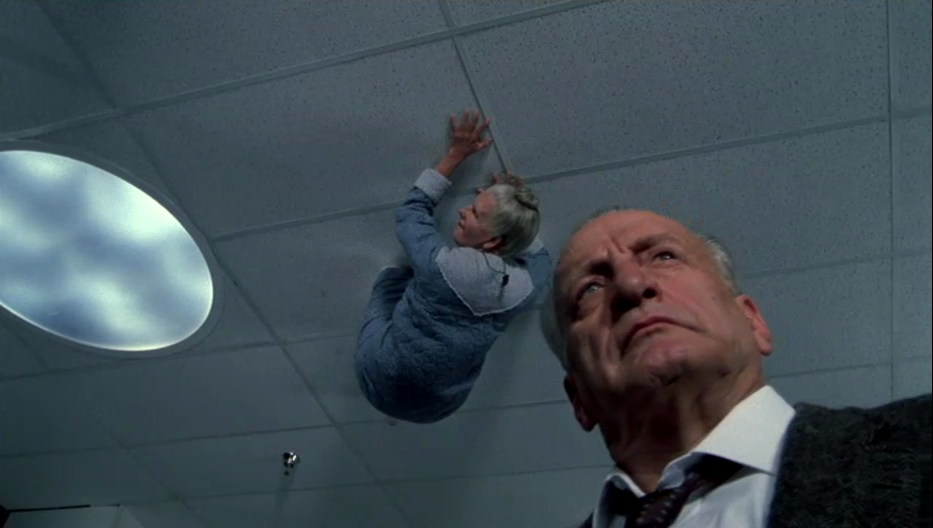
Clearly, The Exorcist III was a big influence on Trainspotting.
This January, in support of the Toronto Rape Crisis Centre / Multicultural Women Against Rape, friends and family have raised over $1,000, which means I have to watch and write about thirty-one horror movies. I’ll watch (on average) one movie a night, many of them requested by donors, after which I’ll write some things about said movies on this website. Be forewarned that all such write-ups will contain spoilers! Today’s film is – some have argued – the best horror sequel in history, The Exorcist III, directed by the original novel’s author William Peter Blatty (The Ninth Configuration is his only other directorial credit). Good friend Marielle Pawson donated a generous amount to this fundraiser on behalf of her mother. Her mother is not much of a horror fan, but she wanted me to watch The Exorcist, a truly scary movie I’ve seen a few times. I suggested I watch The Exorcist III (which I had never seen before) instead. Fun fact: Marielle has a job closely tied to horror, though she is not a huge fan of the genre herself. She works for a television production company that develops those ghost-hunter-type shows. Now, onto The Exorcist III, rented from my other regular video store, Bay Street Video.
What happens:
The Exorcist III is unusual in that (a) it’s directed by the novelist who wrote the original Exorcist, and (b) it seemingly ignores any of the events of The Exorcist II, instead following directly from the original film (albeit fifteen years later).
The film opens in Georgetown (where the original Exorcist took place), and quickly introduces us to two of our principal characters (though it doesn’t yet give us their names): an older priest walking the campus early one morning and an older policeman, seated at his desk, considering a photograph of Damien Karras (Jason Miller), the priest who killed himself leaping from a window in order to kill the demon in the first Exorcist. Cue the “Tubular Bells” theme as a fog begins to permeate the town. Inside the Church of Holy Trinity (where no one knows how to put away hymnal sheets properly), the front doors are blown open by an unholy gust of wind, snapping the Jesus statue’s eyes open wide in surprise. Evil has returned to Georgetown.
We first see Father Joe Dyer (now played by Ed Flanders, instead of William O’Malley) conversing with a seminary student, who wonders why he mentioned Father Damien Karras in his prayers that day. The reason is that it’s been fifteen years to the day that Karras leapt out a window and fell down a flight of stairs to his death. Dyer, a ‘cool’ older priest – “Jesus loves you; everyone else thinks you’re an asshole,” he tells a church donor – tells the university president (Lee Richardson) he’s going to the movies to see It’s A Wonderful Life with an old friend, Lt. Bill Kinderman, who gets depressed this time every year.
Bill Kinderman (now played by George C. Scott, instead of the then-dead Lee J. Cobb) is in the midst of a grim murder investigation concerning a young black boy found down at the water. Kinderman is disgusted with his racist, incompetent staff, who don’t seem to be able to tell him anything about the murderer. Noting a similar M.O., Kinderman asks his detectives to get the Gemini Killer file from Richmond, despite the fact that the Gemini Killer was caught and executed fifteen years ago. Kinderman visits with his family – his much younger wife, Mary (Zohra Lampert), his dance-enthusiast daughter Julie (Sherrie Willis), and his mother-in-law (who looks more his age) – before his movie date with Dyer. He describes the ritual to his family members: he thinks Dyer is the one who needs cheering. Clearly the date (the anniversary of their friend Father Damien Karras’s death) affects them both.
After the movie, Kinderman asks Dyer to go for a drink. He doesn’t want to return home yet, as his mother-in-law has bought a carp to cook, and it’s currently living in his bathtub. He has to wait until the fish goes to sleep, otherwise he’s revolted to watch it move around. (It’s an elaborate excuse; it’s okay just to want to have a drink with a friend, Kinderman.) Over drinks, they discuss the big issues – how God could allow bad things to happen to good people, etc. As an example, Kinderman tells Dyer of the horrible murder he’s working on now. Thomas Kintry, a twelve-year-old he knew from the police boys’ club, was found dead near the water. The killer drove an ingot into each of his eyes, then cut off his head. He then replaced the boy’s head with the head from a statue of Jesus, made up in blackface (an uneccessary racist gesture), and crucified the boy on rowing oars. (Talk about a conversation killer.)
Across town, an old woman enters a confession booth at the Holy Trinity Church. To Father Kanavan (Harry Carey, Jr.), she confesses feeling guilty all the time. Then she reveals that she’s killed seventeen people. The next thing we see is a woman in the church screaming as blood seeps from the confession booth. Kinderman arrives on the scene, and flips back the sheet to reveal the priest’s mangled hands. While the lieutenant sits in the blood-stained confession booth, pondering the case, Sergeant Atkins (Grand L. Bush) informs him they did an autopsy on the Kintry boy, and he didn’t die from the decapitation. He died from a drug used in electroshock therapy: psychocolin(?). In larger doses, the drug paralyzes the body until you slowly die: the boy would have been aware the whole time he was being crucified and decapitated.
Next, Kinderman visits the local hospital, where Father Dyer has been hospitalized, though he insists he’s just there for “some tests.” Kinderman has brought his friend a large stuffed penguin, and chides the priest for reading Women’s Wear Daily. “I’m supposed to give advice in a vacuum?” Dyer retorts. The two continue in their Gilmore-Girls-esque banter for a while, and when Kinderman leaves, he passes by a headless statue of Jesus in the hallway. (Though he doesn’t notice it. Some detective this guy is.)
Later at the police station, Kinderman receives more information on the two murders he’s now investigating: Father Kanavan’s vocal chords were paralyzed by the same drug used on the boy, so he couldn’t scream while being killed. But the fingerprints found on the scene don’t match those at the Kintry scene. “Two different people committed these murders?” Kinderman says in disbelief. That night, he dreams of a heavenly train station, that looks partially like a hospital. The station is populated by mostly older people in white and angels. Kinderman sees Thomas Kintry, his head stitched back on. “I’m so sorry you were murdered, Thomas. I miss you,” he says. (That’s a nice sentiment.) Then Kinderman sees Father Dyer in his dream, talking to the Angel of Death. Dyer’s head is also stitched on. “I wonder if we’re both dreaming this,” Kinderman says. To which Dyer replies, “I’m not dreaming.”
Kinderman is awakened by a telephone bearing bad news: Dyer has been killed in the hospital. The lieutenant immediately rushes to the hospital and grimly investigates the scene. The priest has been exsanguinated: a collection of jars by the windowsill are filled with his entire blood supply. Kinderman’s detectives inform him that not a drop of blood spilled. The only blood not in the jars was used to write a note on the wall. Kinderman pulls back a drop sheet to reveal the bloody message: “IT’S A WONDERFULL [sic] LIFE.” The lieutenant puts the hospital on lockdown: no one gets in; no one gets out.
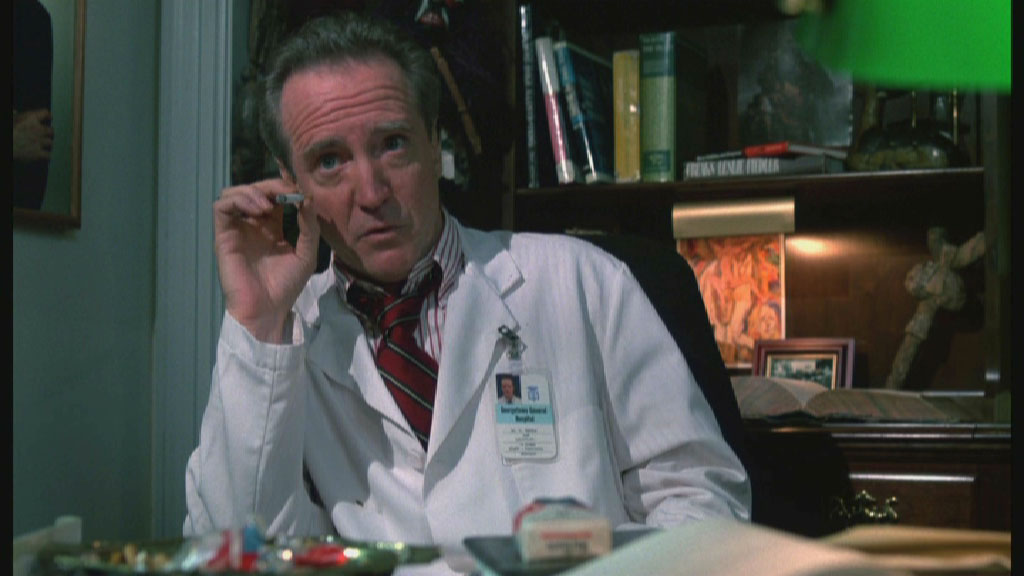
Dr. Temple, who has yet to learn of the dangers of second-hand smoke.
First, Kinderman interviews the stern Nurse Allerton (Nancy Fish), the last person to see Dyer alive. Despite Kinderman’s agitated state, the nurse calmly answers his questions, saying she saw him at 5 a.m., and by 6 a.m., he was dead. In between, the only thing of note that happened was she found Mrs. Clelia unconscious in the hallway. Dr. Temple (Scott Wilson), who is chain-smoking in the hospital (!), introduces the policeman to Mrs. Clelia (Mary Jackson), who resides in the wing of the hospital filled with partial and full-catatonics. Clelia is only partially aware of what is happening: she mistakes the lieutenant for a radio repairman, there to repair her completely fictional radio. Temple then shows Kinderman “the disturbed ward,” which contains several dangerous patients, but he also demonstrates the severe security measures that wouldn’t allow any of those patients to escape from their cells. A man in a strait-jacket in Cell 11 calls for “Bill.” Kinderman goes over to look in his door’s window, but is then called away by Sgt. Atkins.
Kinderman has been called away to talk with Dr. Freeman (Ken Lerner, the first principal from Buffy the Vampire Slayer!), who is very upset his hospital has turned into a crime scene investigation. (He’s weirdly uncooperative, given a heinous murder happened in his hospital just hours ago.) Kinderman then tells him and the assembled police officers that these recent murders are inexplicably linked to the Gemini Killer, even though he was executed in the electric chair fifteen years ago. See, the police gave a false modus operandi for the Gemini Killer to the media to weed out false confessions. These recent murders follow the real M.O.: right index finger severed, gemini symbol carved into the palm. Additionally, the Gemini Killer always doubled his ‘L’s in his writing (e.g. “wonderful”), and only killed people whose names began with ‘K,’ like his monstrous father, Karl: Thomas Kintry, Father Kanavan, and Joe Kevin Dyer. Somehow, the Gemini Killer is back from the grave!
Later, the morgue attendant shows Kinderman what could have served as a murder weapon: a pair of massive medical shears, difficult to open, but spring-loaded so they close like nothing. Something like that could shear a man’s head off. Kinderman goes to talk to the university president at Holy Trinity to pursue the religious connection of these murders, as there clearly is one. While they talk, the clock suddenly stops and the light flickers, eventually plunging the church into darkness. The office door opens of its own accord. It seems as if a demonic presence enters the church. Kinderman goes to investigate and is startled by a churchgoer, Alice, who has come to give the university president his speech. Once that scare is over, Kinderman asks the president if he believes in possession. The university president is far too practical a man to worry about that kind of thing, but they can’t help but notice that the three victims are all connected to Father Damien Karras. Not just Kanavan and Dyer, but Thomas Kintry’s mother apparently studied and analyzed an audio recording Karras made of the possessed Regan MacNeil.
The head priest tells Kinderman that if he wants to talk possession, he needs to speak to Father Morning, who performed an exorcism once in the Philippines. Cut to Father Morning (Nicol Williamson), his hair prematurely white from that exorcism. He sits in his room and finds the atmosphere has gone eerily quiet. He stands up and finds the bird he was caring for dead in its shoebox. Then the crucifix drops from his door and begins to weep blood. Back at the hospital, Kinderman finds a match for the fingerprints on the jars of Dyer’s blood: Mrs. Clelia, the semi-catatonic patient who needed her radio fixed. But how could that be?
We next see Dr. Temple rehearsing a written speech in his office about the patient in Cell 11. Kinderman knocks on the door, and Temple gives him his speech in full, only having to check his (hidden) notes a couple times. Dr. Temple obsessively stubs out a cigarette, lights a new one, then begins: the man in Cell 11 was found fifteen years ago with total amnesia and no I.D. He was catatonic for years, but six weeks ago, he started to improve, become lucid again. Then he turned violent, and they had to resort to electroshock therapy, eventually isolating him with the other dangerous psychiatric patients. Most importantly, he claims he’s the Gemini Killer.
Kinderman makes a quick visit to Cell 11 to get a look at the patient. Then he demands to see the file on the patient and finds it distressingly un-thorough. He begins to run himself in circles: could this patient be his long-dead friend, Damien Karras? He has to confess he looks a lot like him. Kinderman has a minor heart palpitation in the middle of all this commotion. Eventually, he sits down for a face-to-face talk in the dark with the man in Cell 11. Damien claims that he’s the Gemini Killer, and that he was the one who committed the three recent murders. He was obliged to settle the score for a friend “on the other side.” Damien then lets out a demon-lion roar, saying he was taught how to do that by The Master. What he wants is for Kinderman to tell the media that these new murders are being committed by the Gemini Killer.
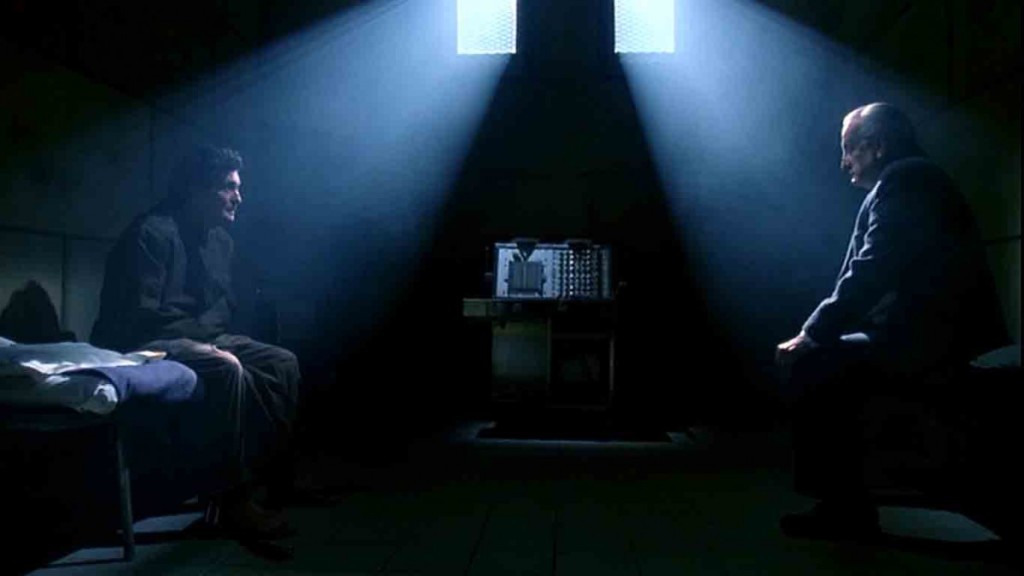
The Frost/Nixon of horror movies.
Kinderman says it’s preposterous and Damien’s face quickly changes into that of the Gemini Killer (Brad Dourif), though its unclear if Kinderman sees it, or only we in the audience do, as the Killer says if Kinderman had faith, he’d see the real him. The Gemini Killer says he’ll punish Kinderman if he doesn’t properly attribute the murders, and talks cryptically about dance. Then the Gemini Killer waxes poetically about his murders – ”Incidentally, did you know you’re talking to an artist?” he says, as if we didn’t already like him – including a graphic description of how he drained Father Dyer of his blood. Once he’s fully outlined how he murdered Kinderman’s friend, the lieutenant backhands him. The patient apologizes for boring him and tells him he’ll make things more interesting. The last thing he does is quote the already unsettling children’s book Goodnight, Moon, ending with a cryptic “Goodnight, Amy.”
Kinderman leaves Cell 11 and tells his sergeant that the patient knows details about Gemini Killer victims that no one could possibly know. Plus, he knows intimate details of Dyer’s murder. Kinderman then visits Nurse Allerton to treat his hand, which has blistered and burned where he smacked the patient. Allerton strongly suspects Kinderman punched the patient in Cell 11 and tells him something strange about that man: at times his autonomic system dulls, as if he’s fallen into a coma, but his brain activity goes haywire. She also notes that he sometimes speaks in a different voice – one that sounds decent, kind. But he’s only said two things in that voice: “Save your servant” and “kill it.” A late-night visit to the church library brings Kinderman a book called The Roman Ritual in which he finds a rite for exorcism that begins with those very same lines: “save your servant.” Kinderman brings his research home. His daughter Julie finds him at the kitchen table, poring over the Gemini Killer files when she goes for a midnight snack. The camera pans over a photo of James Veneman, the Gemini Killer, who looks just like Brad Dourif.
What follows is one of the more suspenseful scenes in film history. In a quiet sequence filmed almost entirely as a long shot, a night nurse works at the nurse station while a police officer sits guard at the door. She hears strange little sounds and goes to investigate in a patient’s room. She spooks herself, realizing it’s merely the sound of ice cracking as it melts in a patient’s glass of water. Then that patient leaps up, giving viewers a heart attack, and complains about the nurse barging into his room. He demands her name, and she provides it: Amy Keating. Nurse Keating returns to her station and the cop checks to make sure she’s okay. She then hears more noise from another room and goes to investigate that noise. She finds nothing, and turns to return to her station, when suddenly a sheet-covered figure carrying the spring-loaded shears stalks up behind her. That’s about when I wet my pants. Goodnight, Amy, indeed.

Setting of one of the more notorious sequences in horror film history.
When Lt. Kinderman arrives at the hospital the next day, he learns that the nurse was split down the middle and her vital organs were removed, only to be replaced by rosaries, then sewn back up. A nurse then calls for Kinderman: Dr. Temple has given himself a lethal dose of the paralysis drug. That means it’s time for another long, drawn-out conversation with the patient in Cell 11.
The patient reveals that The Master thought the Gemini Killer should continue his work, and that, as revenge, it would be ideal to do so in this body, the body of Damien Karras. He loves the torment of Karras as he is helpless witness to his body tormenting and killing the innocent. The Gemini Killer says that as Karras was dying at the bottom of those long stairs, The Master slipped him inside. He had to dig himself out of Karras’s coffin, and Karras was brain-dead at this point, so it took him a long time – fifteen years in the hospital – to recover. The patient also informs him that Temple’s death wasn’t his work; the doctor committed suicide. Temple actually aided the patient, as the patient asked him to bring him Kinderman and convince him that he was the Gemini Killer (which explains all the notes).
Kinderman demands to know if Temple helped the patient escape from his cell, but the patient says he gets out with the help of “old friends.” Then he demands, again, to have the murders credited to the Gemini Killer. Kinderman leaves the cell and worries that this killer may actually be able to jump from body to body, possessing the catatonic patients and acting out the murders. He walks around the catatonic ward, paranoid of each of the patients, but he fails to see the old woman skittering around on the ceiling like a Daddy Long Legs. (So spooky!) Blood seeps from behind an office door in the hospital, and when Kinderman opens it, he finds a dead woman, stripped of her clothing. (They never explain who this woman is or what exactly happened.)
At this point, the lieutenant starts to suspect everyone of being a killer. Nurse Allerton visits a child’s room in the dark and Kinderman barges in, accusing her of attempting to kill the child. But she’s really just brought him some toys. (No word on why that had to happen in the dark, though.) When Kinderman takes a close look at Nurse Julie Allerton’s badge, he realizes why the patient in Cell 11 keeps talking about dance. He’s going after his daughter, the dancer: Julie Kinderman! Kinderman frantically calls his wife and hops into a police cruiser. Meanwhile, the Kindermans get a phone call from someone claiming to be Kinderman, who informs them a nurse will be dropping by with a package. The film then cuts to this nurse – in reality, one of the catatonic patients – in the back seat of a cab. Kinderman and his police driver race against time to get to his house before this faux nurse does.
Kinderman arrives at his door, pistol drawn, but is shocked to find everything is fine. Or is it? Sitting in his living room is the not-nurse from the hospital, who his wife informs him passed out at the door when she arrived. Before Kinderman can realize what’s happening, the fake nurse begins speaking in the Gemini Killer’s voice, and extracts the medical shears from her bag. She just nearly slices off Julie’s head, but Kinderman’s mother-in-law pulls her out of the way at the last second. The nurse hits Kinderman with superhuman force and pushes him up against the wall. She throttles the detective with a strength beyond her own. Then suddenly, she drops Kinderman and cries out in anguish.
That’s because Father Morning is in the building, ladies and gentlemen! (Or rather, in the hospital.) He strides up to the ward of dangerous patients and opens the door to Cell 11. The patient (or the Devil?) relishes the rematch. “This time,” he boasts, “you’ll lose.” Father Morning impassively splashes the patient with holy water and begins reading the exorcism rites. The cell blazes in fire and asps slither all over the priest, but he remains steadfast in his exorcism. Things are looking good for God when the Devil suddenly causes Father Morning’s Bible to burst into flames. Father Morning is then thrown by a force unseen against the ceiling, where he is pinned against his will. As he wriggles on the ceiling, the skin from his head and back begins to crackle and peel off, and it’s just as disgusting as you’d imagine.
Kinderman arrives back at the hospital and immediately heads to Cell 11. When he arrives, he finds a scorched Bible on the floor and a bunch of blood and flesh adhering to the ceiling. That’s when he sees a priest he doesn’t know, Father Morning, slumped over in the corner, dead. The patient warns Kinderman, “Don’t worry about Julie. We’ll get her.” Kinderman draws his gun on his old friend Damien, but Damien pins him against the wall with his demonic powers. He asks Kinderman, “Did I help your unbelief?” Kinderman responds with a lengthy rant about what he does believe in: slime, degradation, death. In short, the Devil. That’s when lighting bolts fire from above, opening the roof to the rainstorm outside and creating a chasm in the floor of the cell. From this chasm rise a number of dead souls, including, disturbingly, Thomas Kintry with a blackface Jesus head and Father Karras.
Then the cell returns to normal. Kinderman is sent to the ceiling of the cell, about to fall victim to the same fate that befell Father Morning. Speaking of whom, Father Morning is not entirely dead. He gets to his knees, grasps a crucifix in his hand, and instructs Damien to fight. Damien does fight against the Gemini Killer and/or Devil, a struggle that results in Kinderman falling from the ceiling. There’s a brief moment when Damien takes control of his body once again and light fills the cell. “Now, Bill! Shoot now!” He commands his old friend. Kinderman obliges and shoots Damien dead. The final shot of the film is Kinderman standing at Damien Karras’s freshly dug grave, even though the headstone declares he died in 1975.
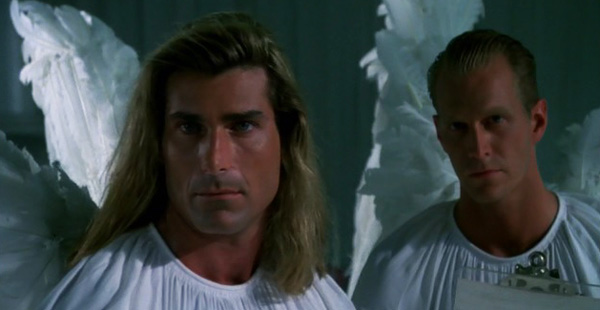
Obviously, Fabio is there to welcome you to the other side. I can’t believe it’s not purgatory.
Takeaway points:
- Like most Exorcist movies, The Exorcist III is about faith. Numerous times during their My-Dinner-with-Andre-like dialogues (if Andre were a demon serial killer and Wallace Shawn barely said anything), the Gemini Killer asks Kinderman if he’s helped his unbelief. From his opening conversation with Father Dyer, Kinderman is clear that too much horrible happens in the world for him to believe in God. In the final confrontation of the movie, Kinderman outlines what he believes in: “I believe in death. I believe in disease … every possible ugliness and corruption … I believe in you.” So Kinderman admits to believing in the Devil, but not the Devil’s opposite. Yet, he manages to prevail over the Devil, even though he’s devoid of faith. Is it enough that Father Morning, who conducts the exorcism, has faith? Or that Father Karras, still battling for control of his body, probably does, too? Or is The Exorcist III that rare beast: an atheist exorcism movie?
- Watching The Exorcist III, I couldn’t help but see the parallels with The Silence of the Lambs: the long one-on-one conversations with a hyper-literate serial killer, the gruesome murders, the overall visual look. In fact, I was amazed to find that The Silence of the Lambs was released second.
- Last year, I attended a debate hosted by The Black Museum – a lecture series on the horror genre that regularly took place in Toronto – in which teams debated what the best horror sequel of all time was. The winners of this debate – Alison Lang and Simon Borer – backed The Exorcist III, of all things. Though they have a good point: there are few good horror sequels, and despite this movie having an iffy connection to the original and a few missteps, it is genuinely scary and maintains the mood of dread fostered by the original.
- The film’s connection to The Exorcist is somewhat tangential, like how Creed connects to the Rocky movies. The movie was based on Blatty’s book, Legion (which was also the movie’s original title), and while it features some of the characters from The Exorcist, the principal story revolves around the Gemini Killer and not Regan Macneil (who is only briefly mentioned). Interestingly, the original cut of the film had no exorcism to speak of. Apparently, film executives demanded the inclusion of an exorcism scene so they could call it The Exorcist III, which explains the introduction of Father Morning, out of nowhere, in the final act. How did he even know about the patient in Cell 11? His Catholic spidey-sense?
- As if the movie itself weren’t creepy enough, The Exorcist III was allegedly the favourite movie of serial killer Jeffrey Dahmer. Fun!
Truly terrifying or truly terrible?: The Exorcist III has a few cheeseball scenes – I’m thinking of Kinderman’s dream of heaven in particular – but it also truly terrifies. There are a couple sequences – the night nurse’s death, the old woman on the ceiling – that are up there with some of the scariest things I’ve ever seen, and a real sense of dread and negativity infuse the whole affair.
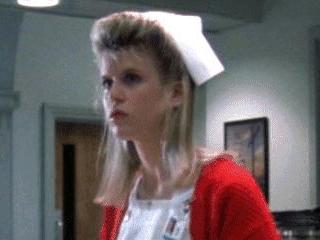
The red cardigan really adds some ‘zazz to the traditional nurse look.
Best outfit: There’s not a lot to write home about, fashion-wise, in The Exorcist III, but the nurse outfits at the hospital are pretty swell.
Best line: “When asked about rabies, and how they can be cured, he said, ‘Rabies are Jewish priests and I would do anything I could for them.’” – Kinderman, fed up with cultural insensitivity on the force
Best kill: The sequence leading up to the murder of Nurse Amy Keating is ulcer-inducing. Right up there with that Chinese restaurant sequence in Nightcrawler for one of the most tense scenes in film. It unsettles throughout and ends with a terrifying payoff.
Unexpected cameo: You might have recognized Dr. Temple as character actor Scott Wilson (maybe better known as Herschel on The Walking Dead or Dick from In Cold Blood). But the really unexpected cameos are romance cover model Fabio as an angel and former New York Knicks great Patrick Ewing as the angel of death in Kinderman’s dream.
Unexpected lesson(s) learned: To be honest, I wasn’t exactly sure how fish slept until Lt. Kinderman explained it in his rant about the carp he hates so much.
Most suitable band name derived from the movie: Cell 11 or The Roman Ritual
Next up: Rodan (1956).
